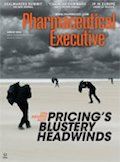- Sustainability
- DE&I
- Pandemic
- Finance
- Legal
- Technology
- Regulatory
- Global
- Pricing
- Strategy
- R&D/Clinical Trials
- Opinion
- Executive Roundtable
- Sales & Marketing
- Executive Profiles
- Leadership
- Market Access
- Patient Engagement
- Supply Chain
- Industry Trends
The Industry Audit: Fifteen Years Right
With our annual Industry Audit marking its 15th year, we decided to compare 2002 approaches in boosting shareholder value to those of today. The fall in one particular performance metric is telling.
Pharm Exec’s key feature this month is a celebration of leadership and longevity. Not only is our annual Industry Audit marking its 15th year-an eternity in this age of digital-we were the first industry trade publication to broaden the evaluation of company performance to include shareholder-friendly metrics like strategic clarity, product quality and good governance. What began as a joint research project with St. Joseph’s University Haub School of Business is now one of our biggest editorial successes, with a large online following and frequent citations in social media.
William Looney

A brief review of our first Audit, published in September 2002, illustrates how much the industry has changed-and also how it has not. Of the 16 companies surveyed, six (Aventis, Pharmacia, Wyeth, Schering-Plough, Genentech and Forest Labs) were absorbed in the wave of consolidations during the first decade of the millennium. At the time, annual US industry revenues were pushing toward the $200 billion mark. Today, that number has more than doubled, to $450 billion, justifying the decision by Audit author Professor Bill Trombetta to make a big stake in the US market one of his indicators of sustainable market performance. What hasn’t changed either is the dominance of the US in new medicines: in 2002, about two-thirds of all new drugs introduced over the prior five years were sourced in the US or by US-based companies; today, the margin is the same or, if you consider the decline in homegrown European innovation, even higher.
Behaviors in biopharma also support our rationale for an evaluation that looked beyond narrow GAAP criteria to put the shareholder up front. The Audit is the industry’s only performance survey to incorporate a key metric, Return on Invested Capital, which strips out financial smoke and mirrors to concentrate on profit generated from a company’s investment in debt and stock. We forget that in 2002 Wall Street was still absorbing the impact of years of abuse of shareholder rights, exemplified by the Enron/Arthur Anderson accounting debacle that led to the demise of both companies. Trombetta, in his 2002 Audit introduction, noted how governance reforms were incentivizing a return to product quality and investment in innovations that satisfied patients, rather than the “pump and dump” methods by which management could cash out stock without regard to the longer-term interests of customers and employees.
Recent allegations around a Turing or a Valeant notwithstanding, the gimmicky goosing of revenues for short-term paper profit is still the outlier in this industry. In fact, the 2016 Audit notes how Amgen, Biogen and other best-managed biotechs are emulating big Pharma with dividend increases

and stock buybacks, all geared to raising their value proposition-and visibility-with shareholders. More important, basic approaches to boosting shareholder value cited in our first Audit, including tight control of operating costs (the Sales to General and Administrative Expense metric); a focus on highest return business segment opportunities; lowering weighted average cost of capital (WACC); and using, rather than owning, assets, are standard practice in today’s biopharma “c-suite.”
There is one discordant note between the two Audits, 15 years apart. Predictably, it’s all about the pendulum of drug pricing. In 2002, the assumption was that innovation in industry labs would yield the trifecta of brand success: a receptive market launch; access to a buster-block of willing patients; and the ability to set prices at a premium to standard therapy. Audit numbers show the assumption bore some truth. Pfizer, the top performing company in that first Audit, posted average gross margins of just under 90%. Today, the average gross margin for the 23 companies surveyed this year was 66%. The percentage was set on the basis of the invoice price, not the “real-world” net price inclusive of discounts and confidential rebates, which pushes the actual number even lower.
The fall in gross margins is the most revealing aspect of the Audit’s evolution. It poses a fresh challenge to industry messaging around “pricing for value.” Might it be time to risk something different, like alternative financing that moves pricing beyond an incremental assessment of value-to a longer way to pay? As Pharm Exec’s cover suggests, fighting these price headwinds with an umbrella-a technology that has not changed in 100 years, let alone 15-is not a strategy that will keep companies at the top of our Audit for long.
William Looney is Editor-in-Chief of Pharm Exec. He can be reached at william.looney@ubm.com. Follow Bill on Twitter: @BillPharmExec

Cell and Gene Therapy Check-in 2024
January 18th 2024Fran Gregory, VP of Emerging Therapies, Cardinal Health discusses her career, how both CAR-T therapies and personalization have been gaining momentum and what kind of progress we expect to see from them, some of the biggest hurdles facing their section of the industry, the importance of patient advocacy and so much more.
